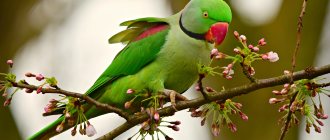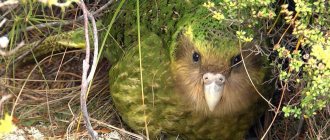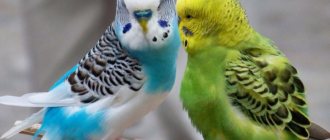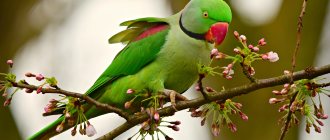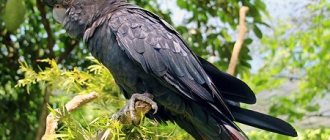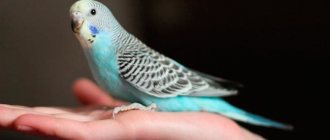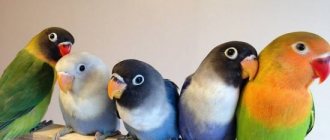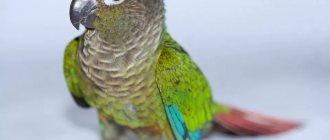The largest among the necklace parrots is the Alexandrine parrot. He has an expressive, elegant appearance, royal grace, and a piercing gaze. The luxurious appearance, ability of onomatopoeia and lively intelligence of these birds attracted the soldiers of Alexander the Great in their campaigns across Central Asia. This is how representatives of the genus of ringed parrots ended up in Greece, and from there they spread throughout the world. One of the species was named after the great commander.
Description of the parrot
Appearance
This is a fairly large bird; in adulthood it reaches a size of up to 60 cm (including the tail). The color of the plumage is emerald green, with a tint. The beak is red.
Appearance of the Alexandrian parrot
On the head, closer to the top, the plumage darkens and becomes almost blue. There is a black horizontal stroke across the forehead. The lower part of the cheeks is also black. The neck ring at the back is orange or red. There are burgundy spots on the wings.
These parrots have pronounced sexual dimorphism. Females have neither a red necklace nor spots on their wings. However, this also does not manifest itself in males until sexual maturity (18 months).
Intelligence and character
- Intelligence. The mental abilities of a parrot are quite great. The bird perfectly imitates human speech, the sounds of animals and machinery. Also, the Alexandrian parrot can adopt the movements and habits of its owner and family members. Well amenable to training.
- Character. This is the other side of the coin. This bird has a difficult and even difficult disposition. In order for a bird to become “one of its own” in the family, you need to constantly work with it. From a very young age, she will test your strength. Plus, in captivity she needs constant release, which will be expressed in pecking at everything that comes under her beak.
Character and intelligence of the Alexandrian parakeet
Differences from necklace
The Kramer's parrot or ringtailed parrot does not have red spots in its plumage. Alexandrov is larger (he is generally the largest of his kind).
In nature, these two types of birds inhabit different areas. The distribution area of necklace parrots is the Hindustan Peninsula (the habitats here partially overlap), Pakistan and Bangladesh. They also inhabit the northern zone of the subequatorial climate zone in Africa.
The necklace parrot can settle in open spaces in forest-steppe conditions, while the Alexandrian parrot prefers forested areas.
What does the Alexandrine parrot eat?
Photo: Alexandrian necklace parrot
When living in natural conditions, necklace birds are quite voracious and completely unpretentious. They feed on almost everything that can be suitable as food for birds. These are cereals, seeds of various types of vegetation, corn, fruits of fruit plants and trees, etc.
If a parrot is kept at home, it needs a varied and balanced diet, as this directly affects the health of the bird. A mandatory component of the daily diet of domesticated birds is balanced mixtures for parrots.
They contain in an optimal ratio grains, vitamin complexes, minerals, and other substances necessary for the full functioning and health of the bird. The daily food intake for one adult bird is 50-60 grams of food.
Mandatory components of the daily diet of poultry:
- carrot;
- zucchini;
- beans;
- beet;
- zucchini;
- cucumbers;
- apples;
- plums;
- oranges;
- apricots;
- seeds;
- soaked white bread;
- fresh greens.
Potatoes, onions and eggplants are strictly prohibited. Millet in spikelets is considered a special delicacy. This delicacy should be given in moderation - no more than two ears of grain per day.
Foods that can harm your parrot's health:
- raw eggs;
- honey;
- sugar;
- products containing chemicals and artificial food additives, dyes.
During the period when birds are molting, you can add several sesame grains to the feed mixture, as well as add vitamin supplements. The owner of the handsome feathered creature must ensure that he always has access to clean drinking water. Parrots enjoy eating homemade porridge: rice, buckwheat, oatmeal, corn, etc. Porridges are prepared in water without adding salt, sugar, flavorings or spices. They must be served freshly prepared, slightly warm.
How to determine age
The main indicator of age is the presence of a necklace around the neck. But this only works with males. Around the age of 1.5-2 years, boys begin to develop an orange or red ring after molting.
Determining the age of a parrot
The second indicator, but not the most accurate, is the color of the beak. When young it is lighter, orange in color. With age, the beak begins to darken and turn red. But this method can misfire.
Why might this happen?
- improper diet;
- genetic predisposition.
Owner reviews
Weetros
For those who are just thinking about or are already planning to purchase this wonderful bird, I will write a few of the most important points.
Be sure to choose a cage of such size that the bird can fully open its wings in it; under no circumstances choose a round one.
It is important for him to have a place in the room protected from drafts; place the cage at eye level or slightly higher. The cage should contain toys made from natural materials, preferably for large parrots, as the rest are destroyed in an instant. Food for medium-sized parrots, mineral mixture, mineral stone, vegetables, fruits (not everything can be given). Change the water daily.
When you release the bird, so that it does not hit its head on windows and mirrors, they must be closed. The bird chews on everything, from mobile phones to books, literally everything, so you need constant supervision if you don’t want to lose anything valuable or the bird. But, in general, the parrot is beautiful, smart, interesting, curious, and learns a lot of tricks and conversation.
Emilia Korikova
We adopted this parrot in October last year. He was then about 3 months old. The bird is very capricious. We don’t know the gender yet, we think it’s a male. It chews up everything in sight. But we love the bird madly, he is very funny.
Setter
Beautiful parrots, quite intelligent, easily tamed, and well trained. Favorite bird of the Pope. Talking about the difficulty in taming and keeping Alexanders without ever observing them is like talking about art without being able to determine the color. In January we brought the little Alexanders. Some of them are already sitting quietly on the hand, listening to the voice, and eating from the hand.
Video
Habitat in the wild
Alexander's ringed parrot originally inhabited the northern, central and western regions of India, northern Pakistan and eastern Afghanistan. To the east, its population extends to the Pacific Ocean through Nepal, northern Myanmar and Thailand, as well as southern Laos and Vietnam.
An interesting fact is that Alexandrine parrots have colonized new territories. Sustainable populations of these birds have long existed in Western Europe - the Netherlands, Germany, France, Spain. The parrot tolerates cold weather well, and winters are no longer what they used to be - climate warming is bearing fruit.
Habitat of a parrot in the wild
Choosing and purchasing a parrot
It is better to purchase Alexandrian parrots from trusted breeders who value their reputation. This way there will be less chance of becoming the owners of a sick or wild bird. Birds older than 7 weeks but younger than 5 months are ideal for the role of a pet. During this period, the chicks no longer need parental care and easily adapt to new conditions.
Important! You can determine the age of Alexandrine parrots by their eye color. The young have a black iris. At 5-7 months, the birds' eyes become dark gray, and even later acquire a characteristic yellow tint.
When choosing an Alexandrian parrot, it is advisable to ask:
- availability of accompanying documents;
- conditions of keeping young animals and parents;
- behavior and health of the chicks.
Healthy Alexandrine parrots should have clear eyes, beautiful plumage, a clean cloaca and a massive beak without growths. Such birds are quite active and interested in communication.
Alexandrian parrots are quite large and beautiful birds with bright plumage and a cheerful disposition. They adapt well to home keeping and with minimal care will delight their owners with their presence for a long time.
Varieties
Alexandrian
The Alexandrian parrot, the hero of our story, is the largest representative of the genus Ring-necked parrots. Probably, for Europeans this was the very first bird from the parrot order that they met.
Burmese
Subspecies of Alexander's parrot. Lives in the jungles of Myanmar and Thailand. Slightly smaller than usual. Inhabits the upper layers of tropical trees. This species is well tamed, but as a pet it is common only in its native countries.
Laotian
This subspecies inhabits southern Laos and southern coastal areas of Vietnam. It is even smaller in size than the Burmese Alexander parrot. Due to the reduction of tropical forests and armed conflicts, it has become much less common in nature. In its habits and character, this bird is a typical representative of the species.
Laotian Alexandrine parrot
Nepali
Another subspecies. A distinctive feature of the Nepalese Alexander parrot is its ability to live in mountainous areas. It is found at altitudes up to 1500 m and can fly higher. Settles in the crowns of trees on the borders of alpine meadows. The food supply is located both in the forests themselves and in open spaces on mountain slopes. Very rare.
Ozherelovy
This is a separate species of the genus Ringed. Its scientific name is Indian ringed parrot or Cramer's ringed parrot.
As mentioned earlier, it lives in India, Pakistan, Bangladesh and Africa. The population is in a stable state. Moreover, like Alexandrov, the bird occupies new territories. In addition to Europe, Kramer's parrot settled in North America on the Florida Peninsula, and in other territories of the southern United States and Mexico.
Neckled species of Alexandrian parrot
Ringed
Ringed birds are a genus of birds in the true parrot family. In addition to the Alexandrov and Indian parrot, it includes a dozen more species.
All of them are united by one characteristic - sexually mature males have a ring (necklace) on their neck. It can be of different sizes and colors.
Ringed parrots are flocking birds that feed exclusively on food of plant origin.
They are known to humans very well. In Asia they have been domesticated since ancient times. Now they are bred in captivity and caught in the wild. Birds of this genus have been genetically bred to have unusual colors - completely white, yellow, blue, gray.
Where does the Alexandrine parrot live?
Photo: Alexandrian parrot
Alexandrine parrots naturally live mainly in regions of humid forests. The geographical regions of their distribution are very diverse, depending on the subspecies. They prefer to be located at the very top of tropical thickets. They rarely descend to the surface of the earth.
Geographical regions where birds live in natural conditions:
- India;
- Pakistan;
- Afghanistan;
- Iran;
- Madagascar;
- Israel;
- Sri Lanka;
- Andaman Islands;
- Myanmar;
- Vietnam;
- Laos.
Small populations of Alexandrine or necklace parrots can be found in natural conditions in Belgium or Germany. Previously, the islands of Reunion and Rodrigues were inhabited in large numbers. Currently not available in these regions. Alexandria parrots are considered excellent sprinters, but they tend to fly only short distances.
They can often settle in close proximity to agricultural land, which causes significant damage to the crop; they especially like to visit corn fields and feast on juicy cobs. When not flying, they most often hide in the crowns of tall trees. At night they can also be very active and fill the crowns of tall trees with huge flocks, the number of which reaches several hundred, and sometimes thousands or more.
In many countries around the world, this type of parrot lives as pets, or is raised and bred in special nurseries and zoos. They quickly adapt to new living conditions and feel quite comfortable as pets.
Care and maintenance
Cell
The Alexandrian parrot has a very strong beak. The bird constantly needs to peck at objects around it, so the cage will be constantly exposed to attacks from its side.
NEW CAGE OF ALEXANDRIAN PARROTS. MALE IN A NEW CAGE
Accordingly, you need to select a strong, all-metal and spacious house for the bird. Space is needed not only for the pet, but also so that items for pecking can fit there. For example, wooden blocks, pieces of rope, cuttings of branches.
Take special care of the entrance lock, since this is the weakest point of the cells.
Diet
Alexander's parrot is a herbivorous bird. Its food consists of grains and legumes, all kinds of nuts and seeds. Fruits and vegetables must be on the parrot's menu. They also eat fresh shoots, grass, blossoming buds, and flower buds.
At home, you can give some white bread, a boiled egg, white cooked chicken meat. If your diet includes legumes (peas, beans), then soak these foods first.
For the health of your pet, exclude food from your table, do not give fatty foods, sweets and foods containing spices.
Parrot diet
Education
Alexandrian parrots are birds with a complex character. Without proper upbringing, they can grow into quite aggressive creatures that will bite and attack family members.
Therefore, even if you do not have the task of teaching your pet speech sounds and tricks, you need to take the issue of taming a bird seriously at home.
Stop aggression and attempts to destroy things.
At the same time, under no circumstances should you hit the bird, as this will prevent you from establishing contact with the pet.
If you show character, speak strictly and decisively. They sense the owner’s mood well and will quickly understand what’s what.
Walk
Alexandria parrots are excellent flyers. They need to fly often, so let them fly for at least half an hour every day. If you increase the flight time, your pets will only be grateful to you for it.
Alexandrian Parrot Grinny: Petting 2 years 2 months 2021
Be concerned about safety. Parrots cannot distinguish between glass and can break into a window. Cover the windows with at least tulle.
Keeping at home
Alexandrine parrots adapt well to captivity conditions, and with proper care they delight breeders not only with their bright appearance, but also with the ability to speak. Although their vocabulary rarely contains more than 15 phrases, the birds speak all of them very clearly and loudly.
Alexandrine parrots are sometimes kept with pigeons and pheasants. They quickly find a common language and feel good in the company. But Alexandrians categorically do not accept other types of birds.
Required microclimate:
- Temperature – 220-250C (but tolerates even a decrease to 00C).
- Humidity – 60-70%.
- Daylight hours – from 12 hours.
Arrangement of the cage
Recommended cage parameters are from 0.8 x 1.2 x 1.5 m. For a more comfortable stay, if possible, it is better to equip an enclosure.
Bird housing must be equipped with the necessary equipment:
- feeders;
- drinking bowls;
- bath for bathing;
- poles made of natural wood;
- toys;
- mineral stone or sepia.
The cage must be cleaned daily, and the room where it is located must be ventilated. But it should be controlled so that there are no drafts.
Cages and equipment are disinfected once a month.
Video Alexandrian parrot - what to feed
Parrot character and learning ability
Parrots - “Alexandrians” are distinguished by a calm and friendly character, they enjoy spending time with people, and love to play. They are non-conflicting, but can show aggression in case of danger (approach of other pets or strangers).
Imitation of human speech is the main feature for which people fell in love with the Alexandrians. However, there are no special training recommendations. All that is required is daily communication with your feathered pet and repetition of certain phrases.
But not everyone likes their loud and squeaky voice. This feature must be taken into account when choosing a pet.
What to feed Alexandria parrots
Alexandrians have no special dietary preferences, but every breeder should be familiar with the permitted list of feeds. The general condition of the bird and its appearance depend on the correct feeding.
The bird menu should include:
- Store-bought grain mixtures for large parrots.
- Grain (wheat, peas, barley, corn, millet, sunflower, oats).
- Greenery.
- Nuts.
- Fresh fruits and vegetables.
- Steamed dried fruits.
- Drying white bread (in small quantities).
The daily dose of food is 50 – 60 g.
Feeding frequency – 2 times a day.
Reproduction
Alexandrine parrots live and breed in captivity without problems.
But for successful breeding you should:
- Get a mature pair of birds of about the same age (it happens that birds reject the option that is offered to them and begin to fight).
- Set up a large aviary for the birds.
- Build a nesting house (0.3 x 0.3 x 0.5 m) with a entrance with a diameter of 10 cm (a layer of sawdust 5 cm thick is poured onto the bottom).
- Create a microclimate as close as possible to the natural one.
- Provide birds with protein-rich food (sprouted grains, microgreens, boiled quail eggs).
The young are removed from the parental nest at 1.5 months of age.
Video of Alexandrian parrot, taming a young male
Breeding Features
The heroes of our story have a distinctive feature. Among parrots, they breed best in captivity. But for this you need one condition - a very spacious cage, preferably an aviary. This is explained by a special mating ritual that requires a lot of space.
Alexandria parrots form monogamous pairs. Individuals aged three years and older are ready to bear children. The clutch consists of 3 to 5 eggs. Incubation occurs within 24-28 days. Only the female incubates the eggs. During nesting, the male takes care of his friend, feeds her, and cleans her feathers.
Conditions for reproduction
The Alexandrian parrot reproduces well at home. If you decide to purchase a pair, then the length of the enclosure for their maintenance should be 2 - 3 meters - this is the opinion of foreign lovers of this type of parrot, but domestic experience suggests the possibility of reproduction in much smaller rooms - 120 x 80 x 150 cm You will also need to build them a nesting house 30 x 30 x 50 cm from hard wood, the diameter of the entrance should be 10 cm. Cover the bottom with a 5-centimeter layer of sawdust, wood dust, rotten wood.
The nesting period lasts from November to April, but it is possible to hatch chicks in the summer - there have been such cases.
The female most often lays 2–4 eggs. Incubation lasts up to a month (usually 23–30 days), during which the male guards the nest and feeds the female. The hatched chicks stay in the nest for about 8 weeks and then leave it. But their parents continue to feed them for several more weeks. The chicks have a plumage color similar to their mother’s, except perhaps a little lighter, and burgundy-red spots appear on their wings by 15–18 months.
Since the times of Ancient Rome, Alexandrian parrots have been known as domestic cage birds. If the process of taming them is started in time, then you will see for yourself how affectionate and flexible their character is. The Alexandrine parrot will definitely become your family pet, and you will never regret purchasing it.
Lifespan
In the wild, birds live up to 15 years. In captivity, under the right conditions, Alexandrine parrots live up to 30 years or more.
Alexandrian parrot
Factors that affect quality of life:
- proper nutrition;
- timely veterinary care;
- interesting activities, attention from home;
- physical activity;
- marriage partner.
Appearance
Alexandrian parrots have a spectacular appearance, royal bearing and innate grace. This arouses genuine interest and respect even among the most sophisticated breeders. As you know, the green tone can lift your spirits.
- Starting from grassy-malachite and ending with emerald-pistachio, the entire palette of colors adorns the body of the bird.
- The upper part of the wings is decorated with brown and burgundy spots, the neck is covered with a pink and red “necklace”. Such jewelry is typical only for males, and then only by the age of three. Nature has deprived the female sex of such decoration.
- The solid body is completed by a large head with a massive bright scarlet beak. In young individuals it is yellow-orange.
- The magnificent tail, which is almost the same length as the body, deserves special attention. The maximum size of the bird reaches 60 cm.
Ability to speak
Over the course of its long life, Alexander's parrot is able to learn up to 15 words and simple phrases. He can use some of them according to situations. For example, greeting people as they enter. Or say phrases related to food and delicacies.
You can teach your pet to talk from a very early age. Although, you can successfully teach a few words to an adult parrot.
Training methods are common to all parrots - repeating words, playing in a situation, including a second person in the process.
Great Alexandrine parrot talking
Temperament, trainability and taming
The Alexandrian parrot simply amazes with its delicate manners and cosmic calm. He behaves with balance in any situation. Even if the bird suddenly doesn’t like the owner’s treatment, it will not react to this with rudeness in return. It will simply hide for a while and stop paying attention to the owner. The bird is quite capricious; it decides for itself whether to accept affection or stay away.
Alexandrov's parrot has good learning abilities: he can repeat words spoken by a person and follows simple commands. You shouldn’t count on a large vocabulary, but an Alexandrian is quite capable of remembering 10-15 words. However, this also reveals the peculiar character of the bird: if it does not want to speak, it cannot be forced or interested.
You need to start taming the chick as early as possible. You just have to wait until the new pet gets used to the environment and gets comfortable among the other inhabitants of the apartment. You cannot scare a bird, otherwise it will stop trusting you, and then the taming process will take a long time.
Experience in breeding my Alexandrine parrots. The first clutch of 2 formed pairs.
Alexandria parrots have been in our flock for a long time, one pair initially arrived already formed (Richka-Kuzya), the second (Katya-Laki) was more complicated - a very active, impressive female Katyusha rejected the first male (Ruby) and even began to chase him, but the second one offered to her (Lucky), liked it, and after a while they began to sleep together, feed and attempt to mate, just like the first couple.
The Kuzya-Richka couple had been mating intermittently over the previous 2.5 years, but neither eggs nor any special problems were noticed in them, except for a single time when Richka decided that it was really necessary to nest and gave a kind of “false pregnancy” (such birds have no concept, this is my personal association), figuratively, its behavior, droppings, and what had to be corrected with medications showed just such an association with mammals). She became extremely aggressive, hoarding droppings and releasing them in large piles. She was x-rayed and treated according to indications.
The bird had hypertrophy of the oviduct, which led to compression of the intestines and disruption of normal bowel movements. – Approx. editor.
Over the years, Richka’s desire to give birth has not subsided, but only gained momentum - in the room she gnawed all the corners, the door, tables, in search of a secluded place. She even gnawed a hole on the neighbors' balcony, trying to find a nest there. In the winter of 2021, this crossed all boundaries, and aggression also increased too much. At the same time, the second pair began to mate very actively, and I made a decision, in order to avoid conflicts with the other inhabitants of the bird house, to provide these pairs with nests.
I made the nests from boards, 2 cm thick, the dimensions of the nests were as follows: 40 by 40 by 50 (the latter is the height). The boards were recommended by professionals, as plywood, often used by breeders, is extremely unecological, harmful, and causes problems with humidity and ventilation, which affects the health of the chicks. Therefore, you should not save on this!
In the middle of the nest, from the entrance (10 by 19 cm), I made a pole. I also installed poles at the entrance to the nests. Inside I poured about 10 cm of pine sawdust, pear and alder chips, dried nettle leaves, dried dandelions, oak bark, and wormwood greens.
I installed the boxes on the night of 02/14/2017.
The birds began to mate actively, without being embarrassed by anyone.
Katerina laid the first egg on February 27th.
The couple (Katya-Laki) did not throw a single chip out of the nest, they only gnawed a little on the walls.
The second pair (Richka-Kuzya) dug, rummaged and gnawed at the house for about 2 weeks, reducing the litter by a third, therefore, due to the busyness of this pair with landscaping, their active matings occurred 2 weeks later, and the first egg appeared only on March 15.
Then the eggs appeared every other day, in total there were 3 for each couple (the first 2 were fertilized, the last was a heating pad).
Despite the general symmetry of the actions and results of both pairs, their behavior during the incubation period and subsequently when the chicks hatched was somewhat opposite.
The Katya-Lucky pair are absolutely tame birds that know few commands and are interested in communicating with humans.
The Richka-Kuzya pair are wilder birds, the male is not at all tame, absolutely self-sufficient. The female in the flock is wild, but outside she is more tame and vocal, but since she lives in a flock and in a pair, the behavior of an independent and uninterested individual in humans is already fixed.
So, during nesting, the first pair constantly demanded communication, tasty treats from their hands, came out and flew a little on command. But she categorically did not want to let her into the nest. One day Katerina grabbed my finger so tightly that she flew out of the nest on it, hanging for another 10 seconds, biting into it.
And the second - on the contrary, Richka threw herself on the bars as soon as I approached the cage, but in the nest - even sitting below, she calmly allowed me to touch and examine the eggs or the chick.
It was a big discovery for me that females do not sit on eggs around the clock - yes, males feed them, but at least a third of the total time females feed themselves and live outside the nest. Males also take care of the eggs and chicks in the nest; in my experience, Alex males are excellent parents!
The diet of the pairs during the incubation period was not very different from what they feed during the normal period of life with me.
Sprouts, fruits, vegetables, berries, mushrooms, avocados, greens, bark, branches, clay, coal, etc. They just ate many times more, just a lot of fresh pine needles every day.
The second eggs of both couples turned out to be cracked. Perhaps this is the inexperience of the parents. For the first pair, because I noticed this crack even before the third egg was laid, managed to seal it with wax, hoping that it could serve as a heating pad, and then, when the next eggs appeared, remove the cracked one.
However, since I didn’t go into the nests much, except for counting (I didn’t even mark the eggs of the second pair, I marked the first one), by the time of ovoscopy (from the 10th day), it turned out that the cracked egg not only did not die, but also ran in development faster than the first. It was clearly noticeable that the vessels in the cracked one, which was definitely the second one demolished (the first one was marked), were brighter and thicker, and there were more of them. It was very strange and incomprehensible.
Experts said that you shouldn’t rely on it anyway, as such eggs don’t produce healthy chicks - bacteria get into the crack and the humidity is disturbed. And so it happened.
Apparently, due to lack of oxygen and humidity, the second egg decided to break through ahead of schedule, on 25-26 days (incubation for Alexandrian parrots is 28 days). And for about a day, there were no changes - only a hole from which the chick embryo could breathe and squeak.
My parents didn’t help, a day later I increased the humidity by placing the humidifier at maximum power next to the nest. As a result, the chicks came out of the eggs (with the first) absolutely simultaneously, with a difference of about 20 minutes... The first chick hatched on its own, quickly and without problems. The second hatched barely, 20 minutes earlier than the older one, but died within the first hours. His parents didn’t even come up to him to warm him, unlike the eldest, who hatched second. The parent birds know better, so they neither helped nor warmed this defective chick, from a cracked egg that hatched prematurely.
I don’t know how generally it was right to leave this cracked egg to develop, a very ambiguous situation. This chick was fully developed and hatched intact, normal, but was breathing heavily and was weak. Bacteria entering through a crack, lack of moisture...
So, on March 27, March hatched. Even if not the first, it is natural and correct. On the first day, the behavior of the parents, from incubating the eggs, did not change much - they took turns warming them, calmly went out to eat and communicate. However, by the second, they began to eat very actively, the female began to sit more in the nest. The male constantly chewed and climbed to feed her. I did not touch the chick until the 9th day - then it was necessary to catch the moment of banding.
In different sources, the time for putting on the ring is written differently. This depends on the rate of development of the chick, and on the size of specific species and subspecies of birds, and even the rings themselves. I found information on the Internet that Alexandrian parrots are ringed from 10 days onwards, the breeders told me about ~14 days. March initially “ran” in development, was very large, and on the 9th day I barely had time to put a ring on it. It wouldn't have fit half a day later.
Rings are a rather unhelpful and traumatic thing for birds; many breeders refuse ringing. But I decided to use rings for now. My phone number is on the rings.
Yurochka, the chick of the second pair, hatched on April 12, the female was smaller than Martha, and was ringed in the evening of the 10th day.
The second egg of the second couple also turned out to have a crack, which I did not notice initially, and it almost did not develop; I threw it out as soon as Yurka hatched.
After banding, I tried not to disturb the parent birds, only looking into the nests once or twice a day, only visually observing the growth of the chicks.
That’s why we didn’t have any weighings; sometimes I took the chicks to look at them for a couple of minutes.
Until almost a month. Closer to the month, I took Marth to talk several times - he is already an almost fully feathered large chick) He is bored in the nest, he squeaks, looks into the entrance, and demands communication. Parents stop constantly warming as soon as fluff appears on the chick. They only come in to feed.
And the parents, apparently due to the fact that the chick was alone and that I began to infiltrate, decided to feed it less and start mating again. Because of this, at exactly 30 days, they were released to fly, the nest was removed, and I took the chick for additional feeding.
I carried out all breeding under the supervision of our leading doctor Valentin. And Valentin immediately did not like the litter of the month-old chick and the dryness of its paws. Suspected a bacterial infection. Where and from where the chick could have picked it up was not very clear to me, but of course I took the litter for analysis. The seeding process takes 2 weeks, which is a very long time for a growing organism at this age. It was decided to start giving an antibiotic even before the test results. And when the tests were ready, the antibiotic chosen for the chick by the doctor fit neatly into the column of those working on the seeded E. coli. In total, the chick took a course of antibiotics exactly one month into its life. He had no further need for medication. The re-analysis came out clean. The second chick's analysis was also clear. Another thanks to Valentin!
Martha placed it in a basin on a corn filler. The chick began to chew the bedding, and the first thing I did was offer him fruit. I cut slices of unripe mango, banana and apple. Mart chose a mango, he liked it so much, he just dug into it with his little beak. But he still couldn’t take a bite, he just chewed and licked it off.
Of course, I didn’t know how to eat fully myself yet, it’s too early.
I used Nutribird A19 for supplementary feeding. I have already dealt with Harrison's chick porridges for feeding weakened birds, these porridges are considered one of the best. And Nutribird did not please me at all with its chemical aroma or consistency. The chick was not happy either... We fed from a syringe a couple of times, after which I used a teaspoon bent from the edges. I diluted it as thick as possible so that it looked like my parents’ food. But the chick began to eat this porridge well only when he began to add berries to it - sea buckthorn, cranberries, blueberries. I really swallowed it with them! Then I started adding sesame and flax seeds. I also purchased chick porridge from Fiory to try. This is a new product on the Russian market; at the time of purchase, I did not encounter a single review. And the chicks and I liked this mixture much better, and it is most similar to Harrisons. No flavorings, contains healthy seeds of various wild herbs. Less economical than Nutribird - consumption is 2 times more. It seemed much more natural to me. I fed the chicks 3 times a day until the crop was full. Then she gradually reduced the number of feedings.
The second pair of parents decided to behave like the first, i.e. continue the number of children when Yurka was 28 days old..
I did the same - I took the chick and removed the nests. Both pairs of parents immediately moved away from the topic of reproduction, at the same time went into molting (the Kuzya-Richka pair was originally from a completely different climate, and in no way did my alexes match before, despite years of being kept in Moscow, they all started molting at once), and became incredibly are friendly with each other. And then, when crossing, they did not react to their chicks in any way.
Due to the difference of just over 2 weeks, the size and development of the chicks was of course different by the time both were fed at the same time. That's why at the beginning they were in different basins. By that time, Mart could already bite and swallow fruit, but Yurochka was just a baby, and the elder could cripple her.
However, how both chicks perked up when they were close!
I suppose that in nature it is calculated that, at least among ringed birds, there are many chicks in a brood at the same time, without brothers and sisters, the chicks are really just very bored. Under supervision, she began to leave them together when Yurka was 5 weeks old, Mart immediately imitated feeding the youngest.
Yurochka also accepted porridge only with berries.
Almost immediately, after being taken from their parents, the chicks were given sprouted grains. At this age they already know how to chew a little, but cannot swallow. To avoid problems with the transition to adult food, I decided that chewing sprouts was better than bedding, and gave the chicks access to both fruit and sprouts. At first I made a “baby mixture”, thinking that without the shells it would be easier for the chicks - the mixture consisted of peeled sunflower, green buckwheat, mung bean, etc., seeds that do not need to be peeled. And that was a mistake! As soon as the chicks were offered an “adult” regular sprout mixture - with a large selection of different seeds and grains in the shell, they immediately fell in love with it.
Yurochka then picked up the development even faster than Mart initially, because she already had an example. Mart adored mangoes, Yurochka chose potatoes and cabbage for gnawing.
And here is one interesting feature - chicks, on average up to 5-5.5 weeks, cannot yet feed themselves - they can chew, but not swallow pieces of food. The size of the tongue does not allow in relation to the size of the growing beak.
I also gave the chicks a lot of greens - bunches of dill, branches with bird cherry leaves, currant leaves, dandelions, cabbage and many, many other things. And the chicks constantly chewed greens. Moreover, unlike adult birds, when most of the branches and greenery fall past the beak, in chicks these bouquets simply “disappeared” to a single leaf! Those. I gave them a broom of dill in the morning, and in the evening it was as if it had never been there. There wasn't a crumb left!
They chew and chew and swallow slowly. But they still don’t know how to eat grain and swallow it, they just husk it. When germination became more active, at 6 weeks, the chicks began to turn away from the porridge.
It was with great difficulty that I fed them until the moment of their first flight. And until recently, they simply hated spoons. But she supplemented the food before the flight, and then everyone completely switched to independent feeding. For Mart it was exactly 6 weeks, for Yurochka even a little earlier - up to 5.5 somewhere.
Another interesting feature of the development of ringed fish is the necklace zone. Chicks of both sexes do not have a necklace; in males it appears at maturity - the first molt (~1 year). And just like all other parrots, ringed parrots have their own “signature”, very pleasant aroma - a mixture of wax with flowers and fruits. That’s why they are called wax-beaked; the area near the beak has an aroma similar to the smell of wax. And since the smell is closely related to hormones, and hormones in ringed birds have a necklace, then when the necklace grows, the chicks emit such a strong floral-waxy aroma that the entire room where the chick is located is filled with it! The necklace grows very last, just before the flights and a little after. And then, apparently, the necklace-aroma hormones are activated. When the necklace has formed, the chicks no longer have such a strong aroma, only if they communicate closely, as with adult ringed birds.
Mart's first flight was great! A couple of days before, he began to “float” on the bed like a “ship” - flapping his wings and running, without lifting much upward. And how he flew - as if he had always done this! Not a single crash, it immediately got caught on paintings and jambs! And in circles! He liked it so much!
Yurochka also flew by 6 weeks, but on the first day she landed a couple of times not very successfully. But she quickly corrected herself. The two of them began to run circles around the room, flying with such pleasure! Flight and greenery are the main things that interested them and continue to interest them.
By 2 months they became completely independent. They are no longer so tame, but they are very attached to me. March has been fully feeding her youngest since she was 4 months old. They can’t live without each other, they’re always together.
They have not yet moved into the general flock - due to being taken away from their parents, the parents apparently did not have time to teach them how to behave with other birds - the chicks crawl right towards their parents, driving them away and driving them away, and towards larger species. Very arrogant young Alexandrians, pressing cockatoos into the wall, driving away the Amazons, without retreating a single step - this is dangerous. Adults are much more reasonable in this regard.
Now the chicks are 9-10 months old, they have grown significantly larger (at the moment the weight of the chicks is 220g and 280g), and they have slowly begun to at least communicate with their parents, without driving them away. (Parents do not perceive the young as their relatives; Katya even dances courtship games in front of her “minor” son...) Sometimes I bring them to the bird room in a cage so that they can look around and learn how to behave with other brothers.
Large, beautiful, healthy!
Many thanks to Valentin Kozlitin for allowing my birds to produce such beautiful, healthy offspring! Thanks to Nina Surinamskaya for her support and advice about the chicks! Thanks to my couples for such wonderful chicks, and heterosexual ones at that!
PS: to our great regret, due to profound stupidity, we lost Mart’s father, Lucky. He unexpectedly, with the door from the bird room slightly open, managed to slip into the entrance with open windows, flew out and was not found. This is a terrible event and a huge loss for the pack. Thanks to him for the beautiful chick.
Main conclusions:
1. Smart nesting helps birds get rid of aggression and gives them something serious to do for a couple of months. The main thing is that the birds are as healthy as possible and that the leading doctor allows the birds to breed.
2. Chicks need a lot of greenery. I consider it a huge sin of many breeders that the chicks are not given a sufficient, or even a minimum, number of useful plants during their development period. This is the most important thing in the diet; it is very important for growing organisms.
3. There is no need to touch the chicks unnecessarily, especially before fledging. It is very easy to transfer bacteria that birds do not need, which can affect their health and development.
4. If there had not been a specialist leading the breeding, then the “accidentally” found bacteria in Mart could have greatly undermined the immune system in the near future and this would have greatly harmed the full development of the chick. Liquid, strange, or any non-typical droppings in a chick are not a sign of adaptation and not due to liquid food. A normal litter of a chick, even while still being fed, is no different from the litter of an adult bird!
5. Reproduction and additional feeding of chicks turned out to be no more difficult than the usual keeping of birds, which I organize for my flock. It is much more difficult to keep adult birds occupied and away from nesting in pairs than to provide nests and activities for chicks. If the birds are healthy and under supervision, if there is a specialist in touch who can control the entire process, then the birds can be provided with nests. They will decide for themselves what to do with them. We have such a wonderful addition to the pack, and it’s a wonderful experience!
Author Lyudmila Tikhonova
Taxonomy and etymology
The Alexandrine parrot was first described by the French. zoologist Mathurin Jacques Brisson as Psittaca Ginginiana
or “La Perruche de Gingi” (Gingi's Parrot) in 1760;
after the city of Ginger in southeastern India, which was then a French outpost. However, the birds may simply have been kept there in captivity.[7] Carl Linnaeus re-recorded the Alexandrian parrot in 1766 as Psittacus eupatria
.
The genus name Psittacula
It is a miniature of the Latin word
psittacus
which means “parrot”, and the specific name
Eupatria
comes from the Ancient Greek words
Europa-
meaning “good” and
patria
meaning “descent”.
Life in the natural environment
Alexander's parrots prefer to inhabit the humid forests of India, Vietnam, Laos, Iran, Pakistan, Afghanistan, Myanmar, and Sri Lanka. They spend most of their time under the canopy of tropical trees, less often on the ground.
It flies quite quickly, but not over long distances. In search of food, flies can fly into fields and rob fields of young corn.
During the day they gather in small herds of 8-10 individuals. Shortly before sunrise and at dusk, their sharp, long calls can be heard. Even before darkness falls, they gather in large herds of several thousand individuals.
When the breeding season begins, the pair separates from the herd and builds a nest in a hollow tree.


